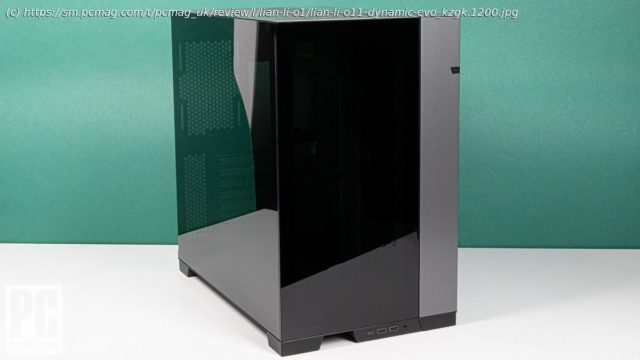Space for three tri-fan radiators, two glass panels, and one slick shell
Abbreviated variously as the “O11 Dynamic EVO” or “O11D EVO”, Lian Li’s new-for-’22 O11 Dynamic Evolution ($170) desktop PC case is such a radical evolution of the popular O11 showcase chassis of a decade ago that it’s hard to call it the same case. A flexible design that allows users to flip the top and bottom panels for upside-down or traditional orientation is just the beginning of the options this unique chassis supports. It’s a fine pick if you’re looking for maximum visibility for your system innards; modest builds may want a model that allows for more cover-up. It will tax your system-planning and cable-routing skills to the max. The Design: An O11 That Makes You Go ‘Oh!’
Words like left and right start to lose their meaning when you’re talking about a PC case that can be flipped, but there’s still a show side and a go side. The former is tempered glass in a tint that matches the face, while the plain side is colored in your choice of anodized black, painted white, or Harbor Gray “tinted brushed aluminum”, which, according to both our eyes and our meters, is actually just painted. You won’t see any brushed texture that might exist under the paint of the gray model we tested. The coating is still attractive, mind you. But what you’re paying for with this case, in part, is the superior flexibility. An example of the O11D EVO’s flex is a so-called “front panel” section that can be fit into three corners of the chassis, depending on which direction you want to face forward. Connections on it include USB Type-C 3.2 Gen 2, two USB Type-A 3.2 Gen 1, and a combo audio jack. The power, reset, and RGB control buttons are a little less flexible, being designed for access from only two positions. The RGB control is exclusive to the front-panel light bar, with the lower button selecting one of seven solid colors and the upper button returning control to a motherboard’s addressable RGB (aRGB) header. The metal side is vented in a way that hints at the O11D EVO’s internal cooling configuration. The chassis frame has three 120mm radiator mounts, on the top, bottom, and side, with the last well-aligned with the metal panel’s forward vent holes. In case you’re wondering, that extra row of fan mounts does allow you to opt for a configuration with two 140mm fans as an alternative. Rather than have the motherboard tray folded inward in front of the board, as in many other chassis, the O11D EVO’s side-by-side compartments make room for the fold to go toward the power supply compartment instead. Two large cable passages face the rear of the power supply, obliging you to wrap cables around the tray to reach the motherboard’s main power connection and the supplemental power headers of graphics cards, but the design also keeps those cables out of the way of the side radiator mount. A hard drive bracket between the side radiator and power supply bracket is designed to clear the inward edges of longer power supply bodies. Lian Li specifies that the case can hold power supplies up to 220mm deep, and we measured 228mm of clearance between the PSU mount and a support bracket. Additional space behind that bracket gives more than 260mm of room for the power supply and protruding cables. We also found that the power-supply support bracket, located on the bottom of the case, makes a great loop for storing excess cable length. Additional grommet-filled access holes above the board allow for EPS/ATX CPU power cables and the like to pass, while smaller holes below the motherboard’s bottom edge (typically used for front-panel connections) have no grommets. A larger hole that enables motherboard access behind the CPU socket is temporarily blocked by a removable drive cage. Sitting inside a second power supply mount, the removable drive cage includes two trays for 2.5-inch or 3.5-inch devices plus a set of 2.5-inch mounting points in its lid. As with the drive mounts found throughout the rest of the case, drives are secured using rubber grommets and shoulder screws.






